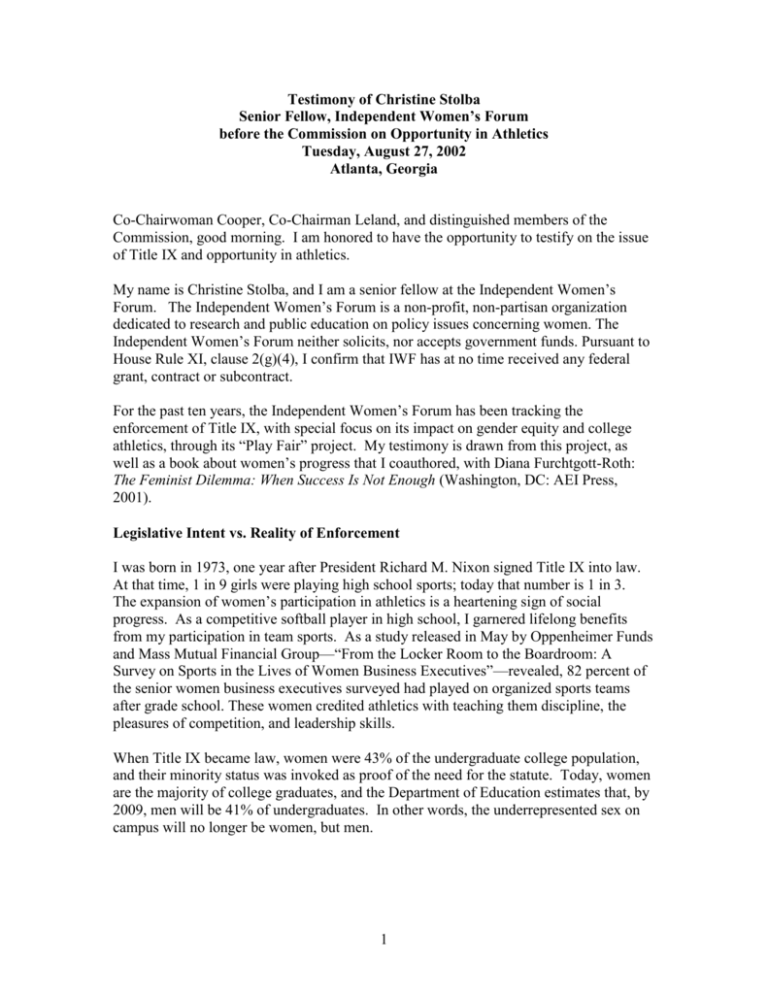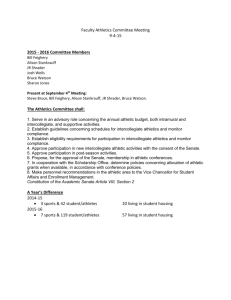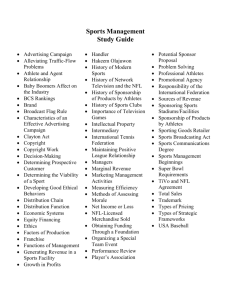Testimony of Christine Stolba
advertisement

Testimony of Christine Stolba Senior Fellow, Independent Women’s Forum before the Commission on Opportunity in Athletics Tuesday, August 27, 2002 Atlanta, Georgia Co-Chairwoman Cooper, Co-Chairman Leland, and distinguished members of the Commission, good morning. I am honored to have the opportunity to testify on the issue of Title IX and opportunity in athletics. My name is Christine Stolba, and I am a senior fellow at the Independent Women’s Forum. The Independent Women’s Forum is a non-profit, non-partisan organization dedicated to research and public education on policy issues concerning women. The Independent Women’s Forum neither solicits, nor accepts government funds. Pursuant to House Rule XI, clause 2(g)(4), I confirm that IWF has at no time received any federal grant, contract or subcontract. For the past ten years, the Independent Women’s Forum has been tracking the enforcement of Title IX, with special focus on its impact on gender equity and college athletics, through its “Play Fair” project. My testimony is drawn from this project, as well as a book about women’s progress that I coauthored, with Diana Furchtgott-Roth: The Feminist Dilemma: When Success Is Not Enough (Washington, DC: AEI Press, 2001). Legislative Intent vs. Reality of Enforcement I was born in 1973, one year after President Richard M. Nixon signed Title IX into law. At that time, 1 in 9 girls were playing high school sports; today that number is 1 in 3. The expansion of women’s participation in athletics is a heartening sign of social progress. As a competitive softball player in high school, I garnered lifelong benefits from my participation in team sports. As a study released in May by Oppenheimer Funds and Mass Mutual Financial Group—“From the Locker Room to the Boardroom: A Survey on Sports in the Lives of Women Business Executives”—revealed, 82 percent of the senior women business executives surveyed had played on organized sports teams after grade school. These women credited athletics with teaching them discipline, the pleasures of competition, and leadership skills. When Title IX became law, women were 43% of the undergraduate college population, and their minority status was invoked as proof of the need for the statute. Today, women are the majority of college graduates, and the Department of Education estimates that, by 2009, men will be 41% of undergraduates. In other words, the underrepresented sex on campus will no longer be women, but men. 1 The Problem: Proportionality Contrary to Title IX’s original aim of equal opportunity, the courts and the Office for Civil Rights (OCR) at the Department of Education have embraced equal outcomes in the form of statistical proportionality as the primary measure of compliance with the statute. This “proportionality” principle posits that, absent discrimination, men and women would demonstrate identical levels of interest and enthusiasm for all activities, whether in choice of college majors or preferences for playing sports. Such thinking ignores men’s and women’s demonstrated preferences for certain activities and leads inexorably to calls for a sex quota system in higher education. In theory a school need only meet one of the following three prongs of OCR’s threeprong test to determine if it is in compliance with Title IX: The ratio of male and female athletes closely paralleled the ratio of male and female students; Colleges could demonstrate a history of expanding opportunities for athletes of the underrepresented sex; or Colleges could show that the interests of the underrepresented sex had been fully and effectively accommodated. In practice, however, after the First Circuit’s decision in Cohen v. Brown University, the first prong has become the “safe harbor” for schools’ compliance with Title IX. Yet, because women today are the majority on most college campuses but still demonstrate lower levels of interest in playing collegiate sports than men, schools are caught in a difficult bind. The solution many colleges have chosen has been to cut men’s teams. In less than a decade, more than 80,000 slots for male athletes on intercollegiate teams have disappeared from college campuses – between 1993 and 1999 alone, 53 men’s golf teams, 39 men’s track teams, 43 wrestling teams and 16 baseball teams have been eliminated. The University of Miami’s diving team, which had produced 15 Olympic athletes, is gone. There is an absurd flip side to proportionality: in a desperate attempt to boost the number of female athletes, schools have been offering a greater range of so-called “emerging sports” for women, such as equestrian, archery, synchronized swimming, and precision skating. Crew teams are also popular among athletic directors, because they can carry a large roster of female rowers. However, coaches still face the formidable challenge of finding women who have experience with the sport and are willing to play. Author Jessica Gavora and others have documented the result: a bizarre form of athletics profiling, with coaches “literally walking through the campus in search of tall, broadshouldered women, recruiting novices in stairwells, campus lunchrooms, and even offcampus diners” to participate on college crew teams. 2 Reasonable Approaches to Measuring Student Interest Supporters of statistical proportionality in college sports have argued since the inception of Title IX that women’s demonstrated interest in sports is not a true measure of equality because it fails to consider female athletic potential. Because society discriminated against women athletes for so long, the argument goes, generations of girls internalized the message that they did not belong on the soccer field or basketball court. The fact that women currently are not turning out for sports at rates as high as men is a legacy of that denial of opportunity. “Because of the historical discouragement of female participation,” NCAA Gender Equity Task Force CoChair Phyllis L. Howlett noted, “an accurate measurement of interest in athletics among women can be difficult to achieve.” That line of reasoning has truth. Culturally, the female athlete has been a role model only in recent years. Displays of female athleticism were rarely celebrated. Doubtless, many girls never ventured to challenge social norms that saw men, but not women, as athletes, and lost out on athletic opportunities in the process. A similar set of cultural assumptions governed the labor market for generations. But once women have achieved formal equality of opportunity, as they did with the passage of Title IX, the question is whether the government’s role is to enforce antidiscrimination legislation or to mandate a certain level of interest in athletics to achieve an equality of outcome. The intent of the legislation was clearly the former; many feminist special interest groups want the latter. What do the data tell us? After all, although social norms about female athletes have changed significantly in a relatively short period of time, current facts about women’s and men’s interest in sports are critical if we are to reach reasonable conclusions about the effectiveness of Title IX. Such data are necessary despite the fact that many feminists are unwilling to admit the possibility that men and women might fundamentally differ when it comes to interest in athletics. Numerous contemporary studies demonstrate that, thirty years after the passage of Title IX, on average, men and women still display different degrees of enthusiasm for sports. A recent study of Division I-A universities, for example, found that 70 percent of men, but only 45 percent of women, participated in intramural sports. Since intramurals are voluntary and open to all students, those sports are an excellent gauge of student preferences. An analysis of responses to the student survey administered as part of the Scholastic Aptitude Test suggests a similar difference in preference for sports: nearly twice as many men as women wanted to play sports at the college level. As the SAT data suggested, an observed difference in interest in athletics begins earlier than college. According to the National Federation of State High School Associations’ “High School Athletics Participation Survey,” in 1992 girls made up 36 percent of sports participants at the high school level, compared with 64 percent for boys. To proportionality wardens, that suggests discrimination at work. But the organization also conducted another survey, this one of the gender breakdown of nonathletic interscholastic activities during the 1992–1993 school year. Here is where the girls are: they made up 69 3 percent of participants in activities such as band, choir, debate teams, and drama clubs and dominated in journalism, speech, yearbook, student government, and service clubs. Boys dominated only in sports. That is women’s choice in action. Given a range of options, girls have gravitated toward some extracurricular activities over others. Figures for Little League activity also confirm that observation, particularly since youth leagues are generally a matter of supply and demand; teams form depending on the number of interested players who register. Nationally, 2.4 million children, almost all of them boys, participated in Little League baseball in 1999. Little League softball, which has the same structure as Little League baseball, had only 384,000 players, almost all girls. The hazards of ignoring student interest were clear in the experience of the California State University system. In 1993 the California chapter of the National Organization for Women (NOW) filed a lawsuit on behalf of female athletes against San Jose State University—and later extended the complaint to all the California State University campuses; the suit alleged Title IX violations. To avoid protracted and costly litigation, the chancellor of the California State University system settled out of court and signed a consent decree with NOW. The consent decree contained several proportionality provisions, including that all athletic programs had to include a percentage of women that was within five percentage points of female enrollment in the general student population and that it would allocate scholarships and general athletic funds on the basis of that proportionality. Schools of the California State University system were justifiably concerned about that consent decree, and California State University at Northridge convened a Task Force on Intercollegiate Athletics to study its athletics program. To appease NOW, the university announced a policy of “community outreach to girls at the grade-school and middleschool level” designed “to encourage the development of athletic skills and interest in young girls” as well as a “communication and public relations program” that would “increase awareness of athletics opportunities for girls and women.” From the perspective of the university’s administrators, the school had two options for meeting the standards imposed by the consent agreement: it could eliminate male athletic opportunities or add substantially new opportunities for female athletes. The university was determined to avoid the former. But the task force quickly found itself confronting a harsh reality. Adding opportunities for women without eliminating athletic slots for men was “not as simple as it [might] appear.” Indeed, the authors of the report stated, “Even though women are a majority of the student body, the pool of potential athletes is not as large.” Women at the university simply were not as interested in athletics as were men. The university’s head softball coach, Janet Sherman, provided an enlightening anecdote to demonstrate that dilemma. Increasing the rosters for female sports such as softball would not work, she said, “because when women realize that they will not be able to play in games, most tend to quit the team.” Sherman and other college coaches at the university testified to a “clear difference in sports culture between men and women” on 4 campus. Male athletes were willing to invest more time and energy in sports, even if they did not get a lot of playing time, while female athletes were not. The differences in preferences between the sexes at the university were, in practice, extremely hard to overcome. Yet those facts had little bearing on what ultimately occurred at California State University at Northridge. By 1997 the men’s Division I baseball team, men’s soccer, men’s volleyball, and men’s swimming teams were all eliminated to satisfy the terms of the settlement with NOW. Forty-one men’s athletic scholarships were eliminated. Mark Fitzpatrick, then a sophomore at the university, lost his scholarship just before the start of the soccer season. “I don’t know if I’m going to be able to get into another school,” he said, “and if I did, there wouldn’t be any scholarship money left” at the new school by the time he transferred. Paul Bubb, athletic director at the university, noted that before the agreement, men’s and women’s teams were treated equally: When the women’s basketball team traveled, did they stay in the same type of hotel or did they have the same type of meal money that the men’s basketball team did? Did they travel by the same mode of transportation? Yes. We were doing those things. It wasn’t like the women were traveling in vans and the men were flying in first class. Nevertheless, Mark Fitzpatrick and his fellow male athletes had to pay for proportionality with the elimination of their teams. Even when a university has solid evidence of men’s and women’s different preferences for athletics, it often ends up settling lawsuits rather than standing up for principles. The University of Texas is one such example. In 1993 it was the target of a Title IX lawsuit seeking the creation of four new female varsity sports: soccer, softball, gymnastics, and crew. The evidence that the university marshaled from student surveys and participation rates in intramural sports revealed “women at Texas simply displayed less interest in sports than their male counterparts.” Despite such strong evidence, University of Texas settled the case before it came to trial to avoid a long and potentially costly court battle. The university agreed to raise female participation rates in sports from 23 percent to 44 percent and created a women’s softball team and a women’s soccer team. The university also agreed to increase the percentage of athletic scholarships awarded to women, at an estimated cost of $1 million. Attempts by the government and feminist groups to mandate certain levels of participation by women leads to misguided standards of proportionality and the denial of opportunity to male athletes. By assuming that all women have the same degree of interest in sports as all men, without bothering to consider whether that is, in fact, true, proportionality proponents reveal their real purpose: social engineering. Proportionality is not equality. 5 Those proponents’ efforts also reject the reality of women’s choices. Proportionality advocates would do well to remember that their proportionality standard could turn out to be a double-edged sword. In Cohen v. Brown University, Brown University provided the court with statistics revealing that gender ratios in other university programs were also skewed: students enthusiastic about dance, music, and drama were 91 percent, 66 percent, and 56 percent women, respectively. Thus far, courts have not been sympathetic to male athletes’ claims of reverse discrimination. But it is useful to remember that there is a logical conclusion to the proportionality standard: quotas in every classroom, including those in which women currently are over represented, to ensure proportionality. Considering that men are the minority on campuses today, this is not an unheard-of proposition. The Title IX debate has no simple solutions; athletic directors, administrators, and students will continue to quibble over who should get what. No one is calling for the elimination of Title IX, nor suggesting that its underlying principle—equal opportunity— is misguided. But the past thirty years have shown that the practical application of Title IX has led to the elimination of equal opportunity for many male athletes. We need to find a better way. With recognition by the courts and policymakers that Title IX guarantees women equal opportunity in education, including athletics, but not necessarily equal outcomes, we can return to the original intent of Title IX. I urge this Commission to consider more accurate and innovative ways of measuring student interest in college athletics, such as polling data and student surveys, and to provide better guidance to college administrators in their efforts to comply with this important piece of legislation. Young women should have every opportunity to pursue sports. But we should be enforcing equal opportunities—not ideology and quotas. The proportionality principle is destructive to free choice and to relations between the sexes, is debasing to women, and is wasteful of our nation’s limited educational resources. 6




